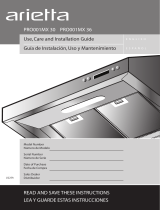Page. 5
IMPORTANT SAFETY INSTRUCTIONS
READ AND SAVE THESE INSTRUCTIONS
Grounding Instructions
This appliance must be grounded. In the event of an
electrical short circuit, grounding reduces the risk of
electric shock by providing an escape wire for the electric
current.
Be sure your appliance is properly installed and grounded
by a qualified technician. Installation, electrical
connections and grounding must comply with all
applicable codes.
If required by the National Electrical Code (or Canadian
Electrical Code), this appliance must be installed on a
separate branch circuit.
WARNING
To reduce the risk of fire or electric shock, DO NOT
use this appliance with any solid-state speed control
devices.
Safety Codes and Standards
This appliance complies with one or more of the following
Standards:
• UL 507, The Standard for the Safety of Electric Fans
• CSA C22.2 No. 113, Fans and Ventilators
It is the responsibility of the owner and the installer to
determine if additional requirements and/or standards
apply to specific installations.
CAUTION
Unit is heavy and requires at least two people
or proper equipment to move and install.
Hidden surfaces may have sharp edges. Use
caution when handling the appliance. Failure
to do so may result in property damage or
personal injury.
State of California Proposition 65 Warning:
WARNING
This product can expose you to chemicals including
vinyl chloride, which is known to the State of California
to cause cancer and birth defects or other
reproductive harm. For more information go to
www.P65Warnings.ca.gov.
Never modify or alter the construction of the appliance.
For example, do not remove panels, wire covers or
brackets/screws.
CAUTION
For general ventilating use only. DO NOT use to
exhaust hazardous or explosive materials and vapors.
To reduce the risk of fire, use only metal ductwork.
Use a qualified installer.
Remove all tape and packaging before using the
appliance. Dispose of packaging in an environmentally-
responsible manner. Never allow children to play with
packaging material.
WARNING
TO REDUCE THE RISK OF FIRE, ELECTRIC SHOCK,
OR INJURY TO PERSONS, OBSERVE THE
FOLLOWING:
• Installation work and electrical wiring must be
done by qualified person(s) in accordance with all
applicable codes and standards, including fire-
rated construction.
• Sufficient air is needed for proper combustion and
exhausting of gases through the flue (chimney) of
fuel burning equipment to prevent back drafting.
Follow the heating equipment manufacturer's
guideline and safety standards such as those
published by the National Fire Protection
Association (NFPA), and the American Society for
Heating, Refrigeration and Air Conditioning
Engineers (ASHRAE), and the local code
authorities.
• When cutting or drilling into wall or ceiling, do not
damage electrical wiring and other hidden
utilities.
• Ducted fans must always be vented to the
outdoors.
• USE ONLY METAL DUCTWORK.
• DO NOT vent exhaust air in spaces with walls or
ceilings or into attics, crawl spaces or garages.
CAUTION
An outside fan is to be mounted behind louvers or in a
location where the entrance of drawn in water is
unlikely.




















